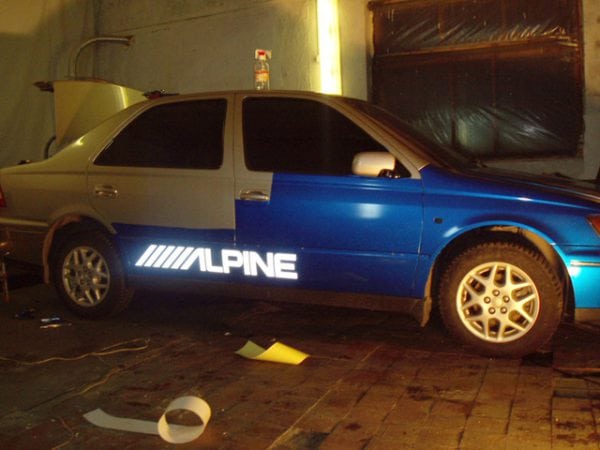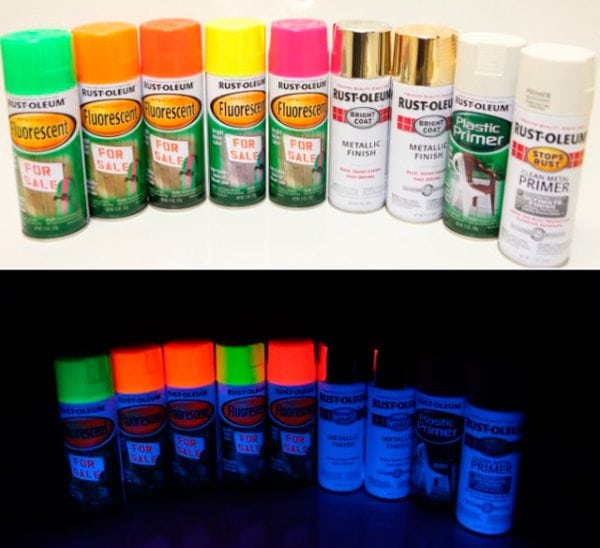Decorative or marking reflective paint is used to paint those surfaces that should reflect light. A distinctive feature of the paint is that it dries quite quickly even in harsh climatic conditions. To make the reflective effect more resistant and pronounced, an additional primer is used, which is applied to the base. It is also recommended to apply a colorless varnish on top of the reflective coating, which is used to consolidate the reflective effect and give the surface a glossy texture.
- Application area
- Main types
- Application of decorative material
- Features of the application of road markings
- Do-it-yourself retro-reflective paint


The most common in everyday life was spray paint in spray cans. Such material can be used for painting metal, plastic, concrete and any other surfaces. Spray paint is easy to apply with your own hands and does not require special skills. The big plus of this paint is that it is sold ready-made: just get the spray can out of the package, shake it well and spray can be applied.
to contents ↑Application area
The composition with a reflective effect has a wide scope. It is used for:
- marking of road signs and marking;
- decorative application on facades;
- territory marking at the enterprises;
- coloring bicycle and motorcycle helmets;
- vehicle markings.
Such coatings have become especially popular with the advent of a large number of cars on the roads. Due to its composition, including reflective pigments, the tool allows motorists and pedestrians to move safely even in the dark.
to contents ↑Main types
Today, several types of paints with the effect of light reflection are known, each of which has its own field of application.
- Fluorescent paint with a reflective effect is characterized in that it emits a soft pleasant light in complete darkness without exposure to additional sources of ultraviolet rays. Such a coating is capable of storing light energy due to the content of the phosphor in its composition. That is, a surface painted with such a coating works almost autonomously. It can create a lighting effect even without the headlights of the car turned on.
- Reflective materials with a fluorescent effect work on a different principle. They give an effect only when ultraviolet rays hit them. Thanks to this composition, you can make your own hands a bright reflective surface that will reflect light from the side from which the UV rays are directed.
Fluorescent paints with a reflective effect are actively used for marking prams, bicycles and other items. Thanks to this coloring, any object will be visible in the dark when the headlights hit it. In this way, traffic safety is ensured. This effect is used to dye the clothes of workers and ordinary pedestrians who want to be visible on the highway in the dark.
to contents ↑Reflective compounds are also used for marking and coloring road signs, so that in the dark, motorists can observe traffic rules and see turns.
Application of decorative material
This type of material is used for decorative purposes and is mainly applied to facades. A distinctive feature of the finished decorative coating is that it contains special reflective pigments. Therefore, when applying it, there is no need to apply an additional layer of micromirrors. Before staining, a preparatory coat of white primer should be applied. If you are working with a liquid composition that you can do yourself, then you need to mix it beforehand. Spray paint in spray cans does not require any additional stirring, as it comes ready to use.
After applying the primer, the surface is painted with the first coat of paint. After an hour, a second coat is applied, and then another 60 minutes later - a third. After 6 hours, a final coat of light-protective varnish should be applied. Such a paint can paint any surface, from metal to concrete.
to contents ↑Features of the application of road markings
Road marking paint applied in two stages. At the first stage, the surface is painted with the usual white composition. In the next step, a reflective layer is applied. This technique allows you to create a wear-resistant coating, which will have a long service life. After erasing the light reflecting layer, it will need to be periodically updated.
to contents ↑Do-it-yourself retro-reflective paint
The composition of reflective paint is quite simple, therefore, it is easy to do it yourself. For the manufacture it is necessary to take a special pigment and ordinary transparent varnish, which are mixed in a ratio of 1: 3. As the basis for varnish, you can take acrylic, alkyd or polyurethane. Any of these components will not affect the reflective characteristics of the paint, which depend on the quality of the pigment. It can also be purchased at any specialized store.
Today, transparent reflective paint has a wide scope. This material is based on reflective pigments, which have the ability to reflect any kind of light.






Look at the reflective paint SV-101. Its distinguishing feature is the presence of an activator and glass beads. The first cleans the paint for a reflective effect. I painted it with a tower crane was pleased!
I agree, good paint. He painted the pipe in September. First he took the St. Petersburg ray. It just shines, does not reflect. He took the SV-101 inside her balls. I wiped the film with a swab, it shone as a sign from 7-10 meters, the belt of the pipe for marking was clearly visible.
And why is the Noxton reflective paint not mentioned in the article? Instead of glass beads, they use reflective granules, some prisms, where the reflection coefficient is an order of magnitude higher.
Such paint can paint not only asphalt, as in the case of glass beads, but also small objects, especially metal.